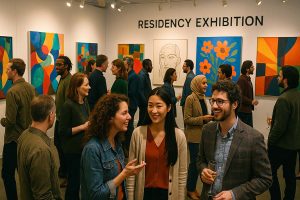
The Value of Craft Festivals in the Northern Hemisphere
Craft festivals have become essential for artists living in the northern regions. These events are more than simple gatherings—they serve as platforms to present local artistry, preserve traditions, and open new possibilities in both local and international settings. Through creative expression, cultural exchange, and hands-on experiences, these festivals continue to shape the future of crafts in meaningful ways.
Honoring Regional Styles and Heritage
In the northern hemisphere, many communities have deep roots in traditional craftsmanship. These skills are passed from one generation to the next and preserved through festivals. Each event becomes a stage where artisans present their personal techniques and regional styles.
Weavers from Iceland, for example, display handmade wool garments crafted using wool from local sheep. In Alaska, carvers shape ivory into intricate forms inspired by local wildlife. Their creations often reflect the landscape and daily life in their region. Each work carries meaning, and each artisan brings their history and community into the spotlight.
More Than Sales: A Celebration of Identity
Craft festivals are not merely commercial markets. While selling is part of the experience, these events are also about storytelling. They help communities express their identity and honor their roots.
For many visitors, attending a festival is like stepping into a cultural archive. Each booth tells a different story—woven patterns reflect migration histories, carved figures carry spiritual meaning, and pottery techniques demonstrate generations of learning.
Building Long-Term Connections
Artists use festivals as opportunities to connect with new people. Buyers, collectors, gallery curators, and interior designers frequently attend in search of fresh and authentic pieces. These connections sometimes turn into long-term collaborations.
A small ceramic piece might end up featured in a magazine spread. A handmade scarf may become a seasonal highlight in a designer boutique. These relationships often lead to more exposure, travel invitations, and even invitations to artist residencies abroad.
Varied Festival Types and Focus
Craft festivals vary widely in scope and style. Some are small, community-driven gatherings. Others are grand international events that attract thousands of guests. Some emphasize traditional techniques, while others embrace experimental design and cross-cultural fusion.
Summer Craft Fair in Finland
Known for clean, simple aesthetics, this fair often features handmade wooden toys and high-quality glassware. The products reflect Nordic design principles—functional, minimal, and nature-inspired.
Arctic Design Week in Norway
This event blends old and new. Visitors can see handwoven textiles beside cutting-edge digital installations. One moment you’re watching a loom demonstration; the next, you’re viewing augmented reality displays.
Northern Lights Artisan Market in Canada
This market highlights Indigenous culture. Local artists present hand-dyed fabrics, recycled metal jewelry, and crafts that respect ancestral knowledge while using sustainable materials. Each artist not only sells their work but also shares stories behind the designs.
These events often include panels, live demonstrations, and workshops where visitors can experience craftmaking firsthand. Topics include ethical sourcing, local material use, and community impact.
Local and Global Benefits
The ripple effect of craft festivals reaches far. Locally, they stimulate small business growth. When visitors attend, they also support local cafes, restaurants, and inns. The surrounding economy experiences a seasonal uplift.
Beyond the immediate area, regions hosting festivals gain recognition on a wider scale. International publications may feature the events, and tourism boards include them in cultural promotions. As artists gain exposure, they attract new clients from across the globe. Online platforms allow remote visitors to support artisans directly, even after the festival ends.
Encouraging Younger Generations
Craft festivals provide younger generations with an up-close view of artistic creation. Teens and young adults attend and watch how raw materials become something valuable and beautiful. Many sign up as volunteers and learn basic techniques from the artists they assist.
These festivals often serve as the first spark for those interested in creative careers. Some young participants later return as full-fledged artists with their own booths.
True Stories of Growth and Recognition
A textile artist from Greenland started with a humble table and only a few scarves. After consistent participation and steady improvement, she eventually gained the attention of a high-end boutique in Paris. Now, she receives seasonal orders from across Europe.
In Alaska, a skilled ivory carver began offering free workshops to local youth. These sessions uncovered new talents, and today, a few of his students are creating pieces that are being exported to markets in Japan and South Korea.
In the Scottish Highlands, a metalworker specializing in kinetic sculptures entered a craft festival and gained international acclaim. One of his pieces won an award, and with that recognition came grant funding for a dedicated studio space. These stories show that festivals can be starting points for meaningful careers.
Community Support and Cultural Investment
Festivals often thrive thanks to support from local councils, nonprofit organizations, and small business coalitions. These groups offer artists grants, free use of public spaces, and help with marketing. The result is a collaborative effort that uplifts the entire community.
Support systems provide:
- Increased opportunities for emerging artists
- Preservation of traditional crafts
- Strengthening of local businesses
- Seasonal tourism boosts
- Wider recognition for underrepresented voices
When planning is done thoughtfully, these festivals become sustainable and continue to benefit communities year after year.
Addressing Common Challenges
Running a craft festival comes with its share of difficulties. Cold weather makes outdoor events harder to manage. Delicate items like ceramics or blown glass require extra care during transport. Budget concerns also affect how many features or services an event can include.
To manage these, organizers have developed strategies such as:
- Combining vendor shipments through regional delivery hubs
- Using heated tents or indoor venues during colder months
- Partnering with local sponsors to fund infrastructure and promotion
These solutions help reduce operational stress and allow artists to focus on their work rather than logistics.
Adapting With Digital Tools
Even traditional events now use technology to expand their audience and impact. Several techniques have helped modernize the way festivals operate.
Virtual Galleries
Through 360-degree video and high-resolution photography, artists can display their work online. This helps remote visitors feel connected even if they can’t attend in person.
Social Media Streaming
Live feeds on social platforms allow real-time engagement. Viewers can watch artisans shape clay or dye textiles as it happens, deepening appreciation for the effort behind each piece.
Online Checkout Systems
Some events set up online stores where festival visitors—and even those overseas—can purchase items. This makes the festival accessible beyond its physical location.
Business Opportunities and Brand Exposure
For entrepreneurs and companies, festivals offer more than art. They’re spaces for partnership and innovation. Businesses may:
- Collaborate with local artists to design limited edition collections
- Sponsor hands-on events or educational booths focused on sustainable practices
- Set up pop-up shops that complement the theme and attract foot traffic
These opportunities benefit both sides—businesses gain exposure, and artists find new audiences.
Evolving Festival Landscape
The structure of craft festivals is changing. Many now focus on environmentally friendly materials and aim to reduce waste. Inclusive programming has also grown, welcoming artists from communities that have historically had limited access to such platforms.
More festivals are using hybrid formats—part in-person, part digital. These models offer flexibility and increase participation. Whether someone is attending from a nearby village or from another continent, there is space for them to engage and support.
Craft festivals in the northern regions offer more than just a place to buy handmade goods. They provide moments of cultural exchange, chances for small businesses to grow, and platforms where heritage and creativity meet.
With each new event, communities strengthen their identity, and artists gain the recognition they deserve. The impact of these festivals stretches far beyond the days they are held, building a more connected and inspired future for all involved.

